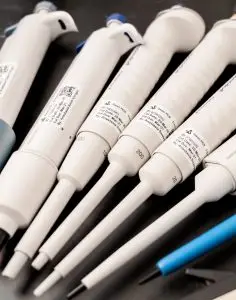Menu
Pipetting Suggestions

How to Reduce Errors when Pipetting
The top 10 things to consider when pipetting:
- Evaluate the condition of the pipette.
- Choose a pipette with the appropriate volume range: Pipettes are most accurate at their upper limit.
- Select quality tips. Poor quality tips can affect the volume delivered by ± 1%.
- Correctly set the micrometer. Refer to the pipette user manual.
- Correctly Pre-rinse tip(s) per volume size (typically 3 times).
- Utilize the correct tip immersion, time, angle, & depth per volume.
- Maintain consistent speed & pressure while aspirating and dispensing.
- Be mindful of hand warming effects.
- Be conscious of ergonomics.
- Proper storage; return counter to upper limit, store upright at < 20°.
Establishing A Pipette Calibration Service Cycle
There are numerous variables that need to be taken into consideration when establishing a pipette calibration service cycle.
The following 7 variables effecting calibration and maintenance of pipettes are often overlooked:
- Frequency in which the pipettes are being utilized (hourly, daily, weekly, etc.).
- Number of end users who are operating/sharing each pipette.
- Matter being aspirated & dispensed (corrosive materials will accelerate the breakdown of lubricants & parts).
- Tips that are utilized (filtered vs. non-filtered).
- Manner in which the pipettes are being stored (upright @ < 20° is recommended).
- Tolerance limits in place (the stricter the tolerances, the more frequently service will be needed).
- Quality of pipettes being utilized. Not all pipette manufacturers are created equal. As the saying goes, you get what you pay for!
